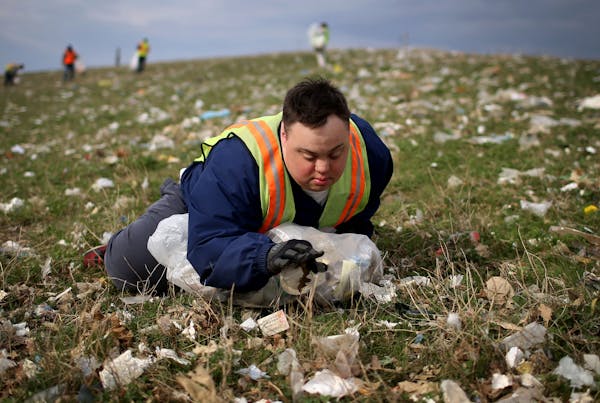Gov. Mark Dayton and several prominent lawmakers say they intend to produce a broad package of reforms in the 2016 Legislature that would help Minnesotans with disabilities lead more independent and meaningful lives.
"I want to take a look … and see what we can learn from other states that are doing this better than we are, and … how can we redirect existing funds to provide better support," Dayton said in an interview with the Star Tribune.
Their comments came just a week after the Star Tribune published a series of stories documenting the way Minnesota has fallen behind much of the nation in efforts to integrate people with disabilities into mainstream life. The stories found that thousands of Minnesotans with disabilities work and live in settings that are profoundly isolated, in conflict with a 1999 U.S. Supreme Court ruling on disability rights.
One strategy under study is to send subsidies directly to individuals and their families, so they can obtain work and housing supports of their choosing, rather than to institutions such as sheltered workshops and group homes.
State officials already are looking at changes in reimbursement rates for disability employment programs, said Jennifer DeCubellis, an assistant commissioner for the Minnesota Department of Human Services, which oversees disability funding.
Rates could be adjusted to give sheltered-workshop operators more incentive to help their workers find jobs in the community, by compensating them more for job coaches and other community support.
Minnesota has one of the lowest rates of community employment in the nation for people with intellectual and developmental disabilities. Only 13 percent of those who receive state services work in the community alongside people without disabilities, compared with nearly 40 percent in Vermont.
"It is critical that we expand community employment," DeCubellis said. "We have initiatives moving forward … but that's not to say we can't do more and can't do it faster if there is more funding available.''
Documents reviewed by the Star Tribune show that Minnesota is among the most segregated states in the nation for working people with developmental disabilities such as Down syndrome and autism and that hundreds of people with disabilities are being sent, sometimes against their will, to state-licensed group homes where they live with strangers in settings far from their home communities.
It also found that people with disabilities face waits of months, even years, for a coveted form of state financial assistance that can pay for housing, therapy and other tools for greater independence.
The large waiting lists and segregated facilities underscored the need for fundamental reforms, possibly in the form of a single, comprehensive bill that would remove some long-standing barriers to integration, legislators and disability advocates said.
"It's time that we do a thorough vetting, to remove barriers [to integration] and … allow people to do the very most they can do within their capacity," said Sen. Kathy Sheran, DFL-Mankato, chairwoman of the committee that oversees disability services.
Sen. John Hoffman, DFL-Champlin, said the move is long overdue, noting that 16 years have passed since the Supreme Court prohibited the unnecessary segregation of people with disabilities in the landmark ruling known as Olmstead. A number of other states, including Oregon and Rhode Island, are already moving to phase out sheltered workshops.
"We're playing catch-up," Hoffman said. "We need a big systems discussion and real action."
'I had no idea …'
Minnesota does not have to start from scratch. In September, a federal judge approved a detailed blueprint, known as an Olmstead plan, for reducing segregation and improving access to community services for people with disabilities. The plan does not call for the closing of any group homes or sheltered workshops, but it does set targets for increasing the number of people living and working in the community. The plan calls for the gradual elimination of the waiver waiting lists, which now total about 5,000 people statewide.
Yet many of the initiatives laid out in the 135-page Olmstead plan require legislative action and more funding, and would require bipartisan support, state policymakers said.
Mary Tingerthal, chairwoman of the subcabinet appointed by Dayton to oversee implementation of the Olmstead plan, said the Star Tribune series — by highlighting the negative effects of isolating people with disabilities — should help legislators make the case publicly for moving forward with the Olmstead plan.
"I have had so many people come up to me and say, 'I had no idea this is how services are delivered in Minnesota,' " Tingerthal said.
Still, some legislators and state officials cautioned against moving too quickly to close segregated facilities, warning of a repeat of past mistakes. Sheran noted that the state is still grappling with the legacy of its decision to shutter state mental hospitals and regional treatment centers more than two decades ago, which left thousands of people with inadequate psychiatric care.
"We released people from institutionalized settings without building the community-based system," Sheran said. "We don't want to make that mistake again by overreacting and closing systems that may not be perfect, but should be gradually reformed."
DeCubellis echoed that concern.
"It's not a good or bad model, but what's right for individual people. This is about individuals making sure they make their own choices."
Staff writer Patrick Condon contributed to this report.
Chris Serres • 612-673-4308
Twitter: @chrisserres
